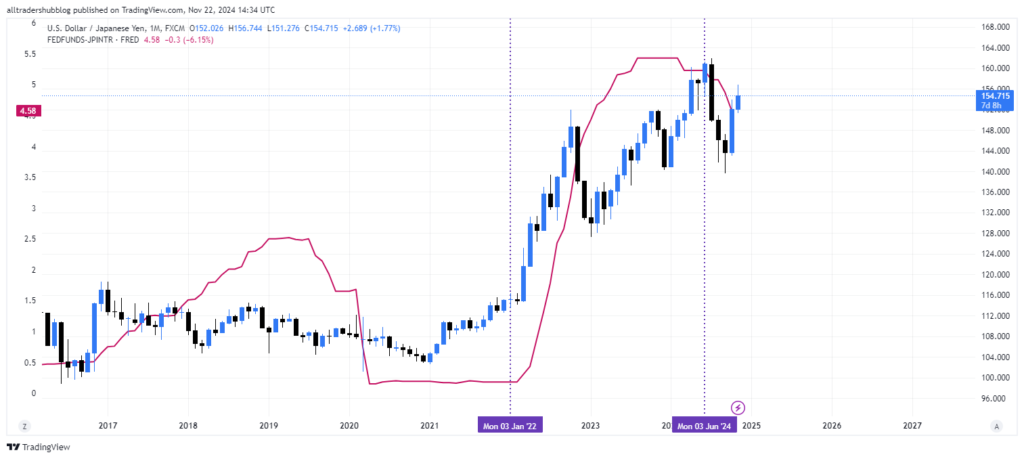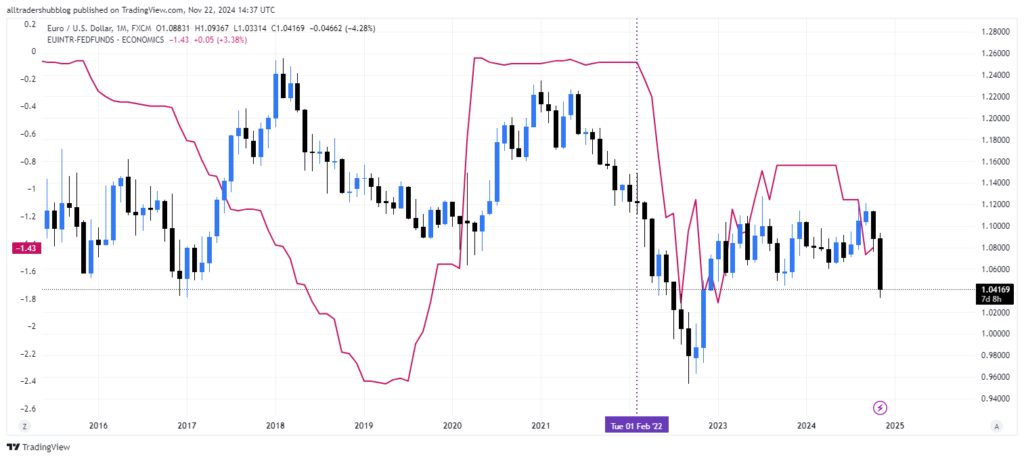Inflation is one of the most critical economic factors influencing currency values. While many traders tend to zero in on the inflation trends of a single country, the reality is that the global economy is deeply interconnected. Inflation trends across borders—whether in neighboring nations or major economic regions—have a significant impact on currency values, trade dynamics, and monetary policies worldwide.
In forex trading, where currencies are always traded in pairs, the difference in inflation rates between two countries can be a major driver of exchange rate movements. For example, if one country experiences higher inflation than its trading partner, its currency often loses value as purchasing power diminishes. This can also shift trade balances, making exports more expensive and imports relatively cheaper. On a larger scale, inflation in major economies, such as the U.S. or the Eurozone, can ripple through global markets, affecting capital flows and the strength of key reserve currencies like the U.S. dollar.
This article dives into how global inflation trends influence the forex market and how traders can leverage this understanding to develop a solid fundamental bias. By examining how inflation impacts monetary policies, trade balances, and investment flows, traders can gain a clearer perspective on potential currency movements and enhance their trading strategies.
Understanding Global Inflation Trends
Inflation trends are not confined within national borders. In a globalized economy, price changes in one country can ripple across others through trade, capital flows, and commodity markets. Understanding how and why inflation rates differ between countries is essential for forex traders aiming to anticipate currency movements.
Inflation Disparities Across Countries
Inflation rates vary significantly between countries due to differences in economic structures, monetary policies, and external shocks. Developed economies, such as the United States or the Eurozone, typically aim to maintain low and stable inflation. In contrast, emerging markets often experience higher and more volatile inflation due to factors such as less developed financial systems, reliance on imported goods, or commodity price fluctuations.
For example, countries dependent on energy imports, like Japan, may experience inflation spikes when global oil prices rise. Conversely, resource-rich nations like Australia or Canada may benefit from inflation driven by increased demand for their exports, strengthening their currencies.
Transmission of Inflation Across Borders
Global inflation trends are interconnected through several mechanisms:
Trade Relationships
Inflation in a major exporting country can increase the cost of goods for importing nations. For instance, if China—a major manufacturing hub—faces higher production costs due to rising wages or raw material prices, the inflationary pressure is likely to be passed on to its trading partners. This dynamic can affect currency valuations, especially for trade-dependent economies.
Global Supply Chains
Modern economies are deeply integrated through supply chains. A price increase in one segment of the chain, such as raw materials or shipping costs, can propagate inflationary pressure across multiple economies. For example, disruptions in semiconductor production in Asia can lead to higher prices for electronic goods globally, influencing inflation rates and, subsequently, currency strength.
Commodity Prices
Global commodity markets are a key driver of inflation trends. Rising prices for oil, gas, or agricultural products can create inflationary pressures in both producing and consuming nations. Forex traders closely monitor commodity prices to anticipate how they may impact currencies tied to commodity exports (e.g., the Canadian dollar) or imports (e.g., the Japanese yen).
Case Study: The 2022 Global Inflation Surge
In 2022, inflation surged globally due to pandemic-related supply chain disruptions, rising energy prices, and geopolitical tensions like the Russia-Ukraine conflict. While developed economies like the U.S. and Eurozone implemented aggressive monetary tightening, emerging markets faced the dual challenge of rising import costs and weaker currencies. This disparity created significant forex opportunities, as traders capitalized on the contrasting monetary policies and inflation trajectories between regions.
By analyzing these trends, traders can better understand the interconnected nature of inflation and its role in shaping forex market movements.
The Role of Central Banks in Managing Cross-Border Inflation
Central banks play a pivotal role in managing inflation, both within their own borders and in response to global inflationary pressures. Their policies not only aim to maintain domestic price stability but also address the ripple effects of inflation transmitted through trade, capital flows, and commodity markets. For forex traders, understanding how central banks react to cross-border inflation trends is crucial for predicting currency movements.
Coordinated Monetary Policies
Central banks often collaborate during periods of synchronized global inflation. For example, during the global financial crisis of 2008 and the COVID-19 pandemic, central banks in major economies implemented coordinated monetary easing to combat deflationary risks and stimulate economic activity.
While such coordination fosters stability in global markets, it can also influence forex dynamics by reducing interest rate differentials between currencies. When central banks move in unison, traders may need to focus more on other factors, such as relative economic growth, to anticipate currency trends.
Diverging Monetary Policies
More often, central banks diverge in their approaches to inflation management, reflecting differences in domestic economic conditions and inflationary pressures.
For instance:
- The Federal Reserve might aggressively hike rates to combat rising inflation in the U.S., while the European Central Bank (ECB) may adopt a more cautious approach due to slower growth in the Eurozone.
- This divergence creates opportunities in forex markets, as currencies tend to strengthen when their central banks pursue tighter monetary policies relative to others.
Example:
In 2022, the Fed’s rapid rate hikes to counter inflation led to a surge in the U.S. dollar, as higher interest rates attracted foreign capital. Conversely, currencies like the Japanese yen weakened due to the Bank of Japan’s ultra-loose policy, highlighting how divergent approaches to inflation shape forex trends.

Global Reserve Currencies and Inflation Trends Spillovers
The influence of global reserve currencies, particularly the U.S. dollar, amplifies the impact of cross-border inflation. As the world’s primary reserve currency, the dollar is deeply embedded in global trade and finance. Inflationary trends in the U.S. often have far-reaching effects:
- Commodity Pricing: Many commodities, like oil and gold, are priced in dollars. When U.S. inflation rises, the cost of these commodities may increase for other countries, importing inflation into their economies.
- Global Liquidity: Tightening monetary policy by the Federal Reserve (e.g., raising interest rates or reducing asset purchases) can lead to capital outflows from emerging markets, weakening their currencies and exacerbating inflationary pressures.
Other reserve currencies, like the euro or yen, also transmit inflation trends, but their impact is often more regionally concentrated.
How Global Inflation Trends Shapes Forex Bias
Global inflation trends significantly influence forex traders’ ability to form a fundamental bias for currency pairs. Inflation, through its impact on purchasing power, interest rates, and trade balances, can dictate the direction of exchange rates. By understanding these relationships, traders can anticipate which currencies are likely to strengthen or weaken, thus refining their trading strategies.
1. Inflation-Driven Changes in Exchange Rates
Inflation directly affects a currency’s value through purchasing power parity (PPP). According to PPP theory, a country experiencing higher inflation relative to its trading partner will see its currency depreciate over time. This is because rising domestic prices reduce the competitiveness of goods and services in international markets, leading to a weaker currency.
Example:
If the U.K. has an inflation rate significantly higher than the U.S., the GBP/USD pair might weaken as the pound loses purchasing power relative to the dollar. Traders can use this relationship to build a bearish bias on the GBP.
However, inflation’s impact on exchange rates is not always linear. Other factors, such as central bank actions and investor sentiment, can amplify or mitigate these effects, requiring traders to consider the broader context.
2. Relative Inflation and Trade Competitiveness
Inflation affects a country’s trade balance, which in turn influences its currency value:
- High Inflation: Makes exports more expensive and imports cheaper, potentially widening a trade deficit and weakening the currency.
- Low Inflation: Supports export competitiveness, strengthening the currency as demand for exports increases.
Case Study:
The Japanese yen has historically benefited from Japan’s low inflation and trade surplus, supporting its status as a “safe haven” currency. In contrast, countries with persistent high inflation, such as Turkey, often see their currencies depreciate due to trade imbalances and loss of investor confidence.
3. Interest Rate Differentials as a Forex Driver
One of the most significant ways inflation shapes forex bias is through its influence on central bank policies, particularly interest rates. Higher inflation typically prompts central banks to raise interest rates to curb price pressures, while low inflation may lead to rate cuts or monetary easing.
This creates interest rate differentials, a critical factor for forex traders:
- Currencies with Higher Interest Rates: Tend to strengthen as they attract foreign capital seeking higher returns.
- Currencies with Lower Interest Rates: Often weaken as they become less attractive for investment.
Example:
During 2022, the Federal Reserve raised interest rates aggressively to combat inflation, creating a strong bullish bias for the U.S. dollar. Meanwhile, the Bank of Japan maintained ultra-loose monetary policy, leading to a bearish bias on the yen.
4. Inflation Trends and Risk Sentiment in the Forex Market
Global inflation trends also interact with investor risk sentiment, shaping demand for safe-haven or risk-sensitive currencies:
- High Inflation and Economic Uncertainty: May drive investors toward safe-haven currencies like the U.S. dollar, Swiss franc, or Japanese yen.
- Moderate Inflation with Growth Optimism: Supports risk-sensitive currencies like the Australian dollar or New Zealand dollar, which are tied to commodities and global trade.
Scenario:
When inflation fears dominate markets, traders may shift toward a bullish bias on the U.S. dollar, especially during periods of geopolitical tension or financial instability. Conversely, improving inflation conditions may revive interest in emerging market currencies or high-yielding currencies like the South African rand.
5. Forming a Forex Bias Using Inflation Trends
To leverage global inflation trends in forex trading:
- Analyze Inflation Data Globally: Monitor CPI, PPI, and core inflation data from major economies to identify disparities.
- Assess Central Bank Policies: Determine how inflation influences interest rate expectations and monetary policy divergence.
- Combine with Other Fundamentals: Pair inflation insights with GDP growth, trade balances, and geopolitical factors for a comprehensive view.
Example of Forex Pair Analysis:
- If inflation in the Eurozone is rising faster than in the U.S., traders might anticipate a dovish ECB compared to a hawkish Fed, creating a bearish bias on EUR/USD.
- Conversely, if inflation slows in Australia but remains elevated in the U.K., AUD/GBP may exhibit bullish tendencies for the Australian dollar.
Practical Application for Forex Traders
Global inflation trends provide valuable insights for forex traders aiming to predict currency movements and refine their trading strategies. By effectively analyzing inflation data and integrating it into their overall market analysis, traders can form a strong fundamental bias. Here’s how to apply this knowledge practically:
1. Analyzing Global Inflation Data
- Key Data Sources:
Traders should monitor inflation indicators such as:- Consumer Price Index (CPI): The most common measure of inflation.
- Producer Price Index (PPI): Indicates cost pressures at the production level.
- Core Inflation: Excludes volatile items like food and energy for a clearer trend.
- Reports from institutions like central banks, the International Monetary Fund (IMF), and the World Bank.
- Comparing Inflation Rates:
Identify disparities in inflation between countries. For example, a rising CPI in the U.S. compared to stagnant inflation in the Eurozone may signal potential movements in the EUR/USD pair. - Inflation Expectations:
Inflation expectations, derived from bond markets (e.g., breakeven inflation rates) or surveys, can provide forward-looking insights, helping traders anticipate central bank actions.
2. Assessing the Impact on Central Bank Policies
- Inflation and Interest Rate Expectations:
Use inflation data to gauge how central banks are likely to adjust monetary policy. For instance:- Higher Inflation: Central banks may raise interest rates, strengthening the currency.
- Lower Inflation: Central banks may cut rates or maintain loose policies, weakening the currency.
- Policy Divergences:
When inflation trends diverge between two economies, their central banks are likely to adopt differing policies. Traders can exploit this by trading currency pairs where interest rate differentials are expected to widen.
Example:
If inflation is rising rapidly in the U.S. while remaining subdued in Japan, the Fed may tighten policy aggressively while the Bank of Japan stays dovish, creating a bullish bias for USD/JPY.
3. Spotting Forex Opportunities from Cross-Border Inflation Trends
- Trade-Based Bias Formation:
Inflation impacts trade balances, which in turn affect currency strength:- A country with low inflation often gains a competitive edge in exports, potentially strengthening its currency.
- High inflation countries may see weaker currencies as imports become more attractive than expensive domestic goods.
Example:
The Swiss franc (CHF) often benefits from Switzerland’s low inflation environment, which bolsters its trade surplus and supports the currency’s strength.
- Commodity Currency Trends:
Inflation in commodity-producing nations, such as Australia or Canada, is often linked to global commodity price trends. Rising commodity prices can strengthen these currencies, offering trading opportunities in pairs like AUD/USD or USD/CAD.
4. Combining Inflation with Technical and Sentiment Analysis
While inflation data is a critical fundamental factor, combining it with technical and sentiment analysis can improve decision-making:
- Technical Analysis: Identify key support/resistance levels or trendlines to confirm bias formed by inflation analysis.
- Sentiment Analysis: Monitor market sentiment, as inflation-driven risk aversion or optimism can impact safe-haven or risk-sensitive currencies.
Example:
If inflation data supports a bearish bias on EUR/USD but the pair is approaching a strong support level, traders may wait for a breakout or reversal signal before executing a trade.
5. Case Study: Inflation and EUR/USD in 2022
- Scenario: Inflation in the Eurozone reached record highs in 2022, while the U.S. Federal Reserve pursued aggressive rate hikes to combat inflation.
- Outcome:
- Traders observed a dovish ECB due to economic growth concerns and an energy crisis, creating a bearish bias for the euro.
- Simultaneously, the hawkish Fed strengthened the dollar, leading to a significant downtrend in EUR/USD.
- Lesson: By analyzing inflation data and central bank responses, traders could anticipate this divergence and position themselves accordingly.

6. Building a Strategy Around Inflation Trends
- Track Key Economic Calendars: Stay updated on CPI and PPI releases from major economies, as these events often lead to significant market moves.
- Prioritize Major Currencies: Focus on currencies tied to central banks with a strong influence on global markets (e.g., USD, EUR, JPY).
- Pair Selection: Choose forex pairs with clear inflation and policy divergences to maximize opportunities.
Conclusion
Global inflation trends are a cornerstone of fundamental forex analysis, offering traders valuable insights into the forces shaping currency movements. In an interconnected world, inflation is no longer a domestic phenomenon—it transcends borders, influencing trade, monetary policy, and investor sentiment across regions. For forex traders, understanding these dynamics is essential for forming a strong fundamental bias.
By analyzing inflation disparities, monitoring central bank actions, and recognizing the interplay between inflation and global markets, traders can anticipate currency trends with greater precision. Whether it’s identifying opportunities from interest rate differentials, assessing trade competitiveness, or interpreting cross-border inflation spillovers, a solid grasp of inflation trends equips traders to navigate the complexities of the forex market.
Ultimately, integrating inflation analysis with other fundamental, technical, and sentiment-based strategies enables traders to refine their approach and capitalize on the opportunities presented by global inflation dynamics. As inflation remains a key driver of forex markets, staying informed and adaptable will ensure traders stay ahead in this ever-evolving landscape.
